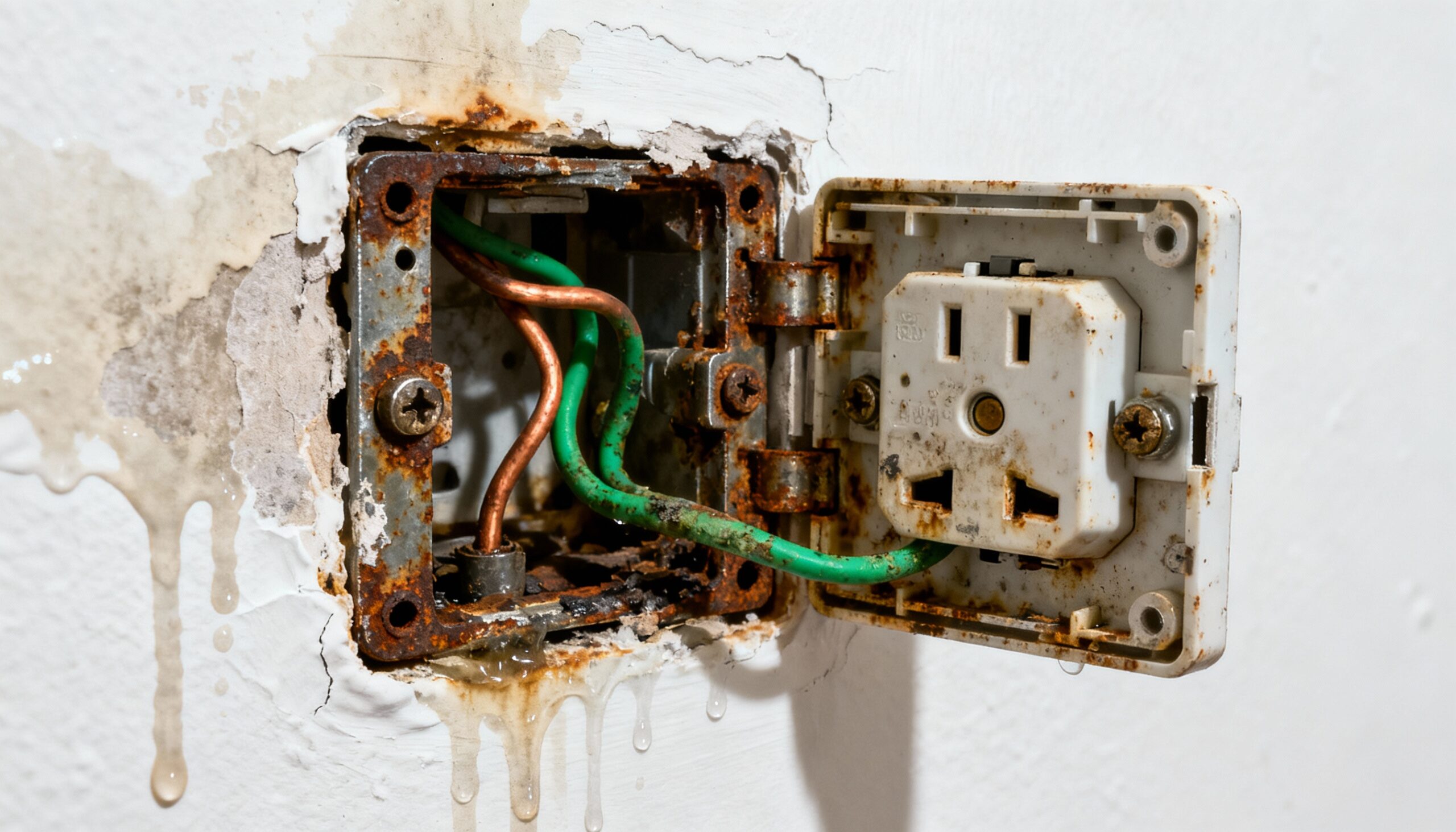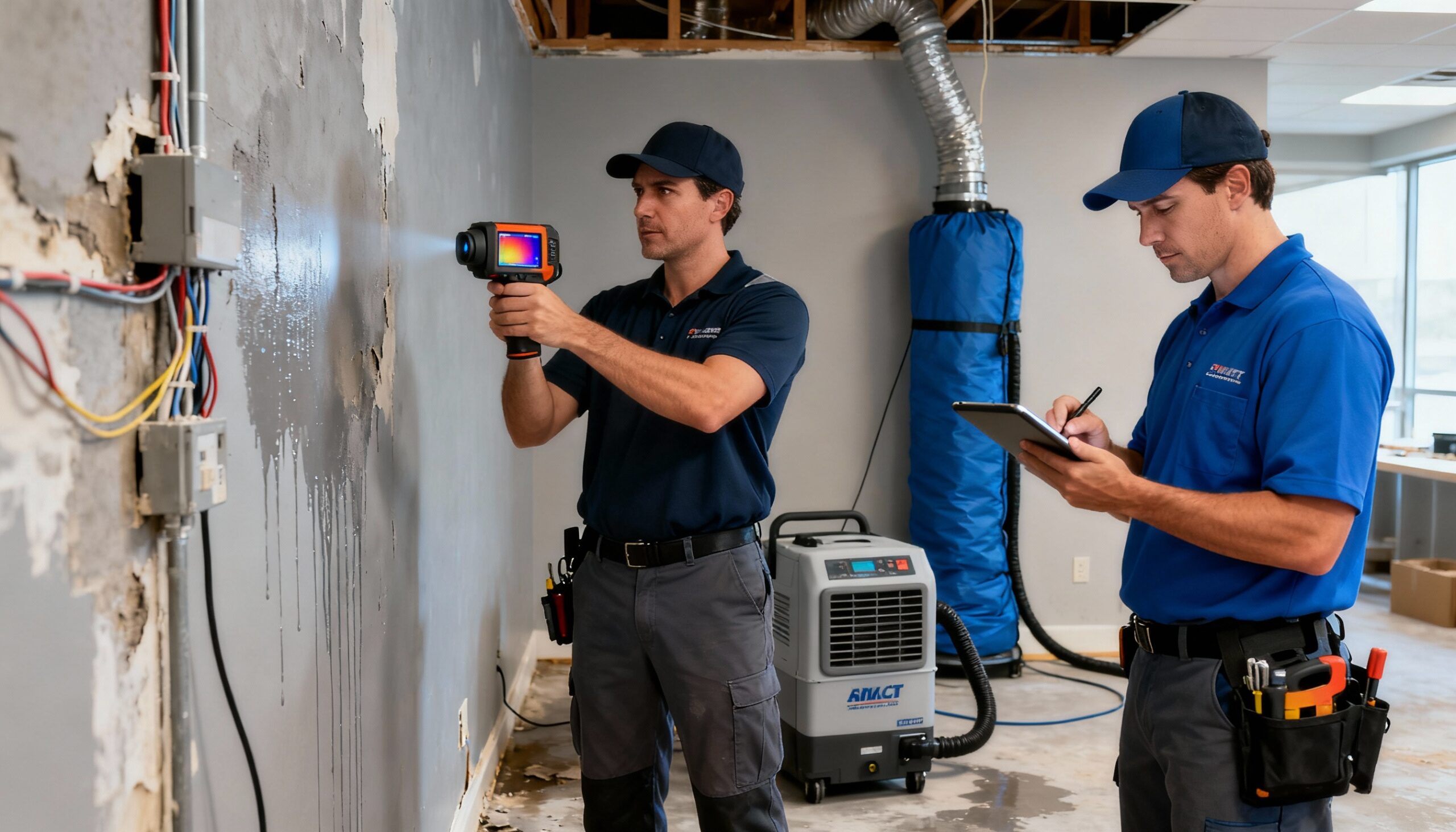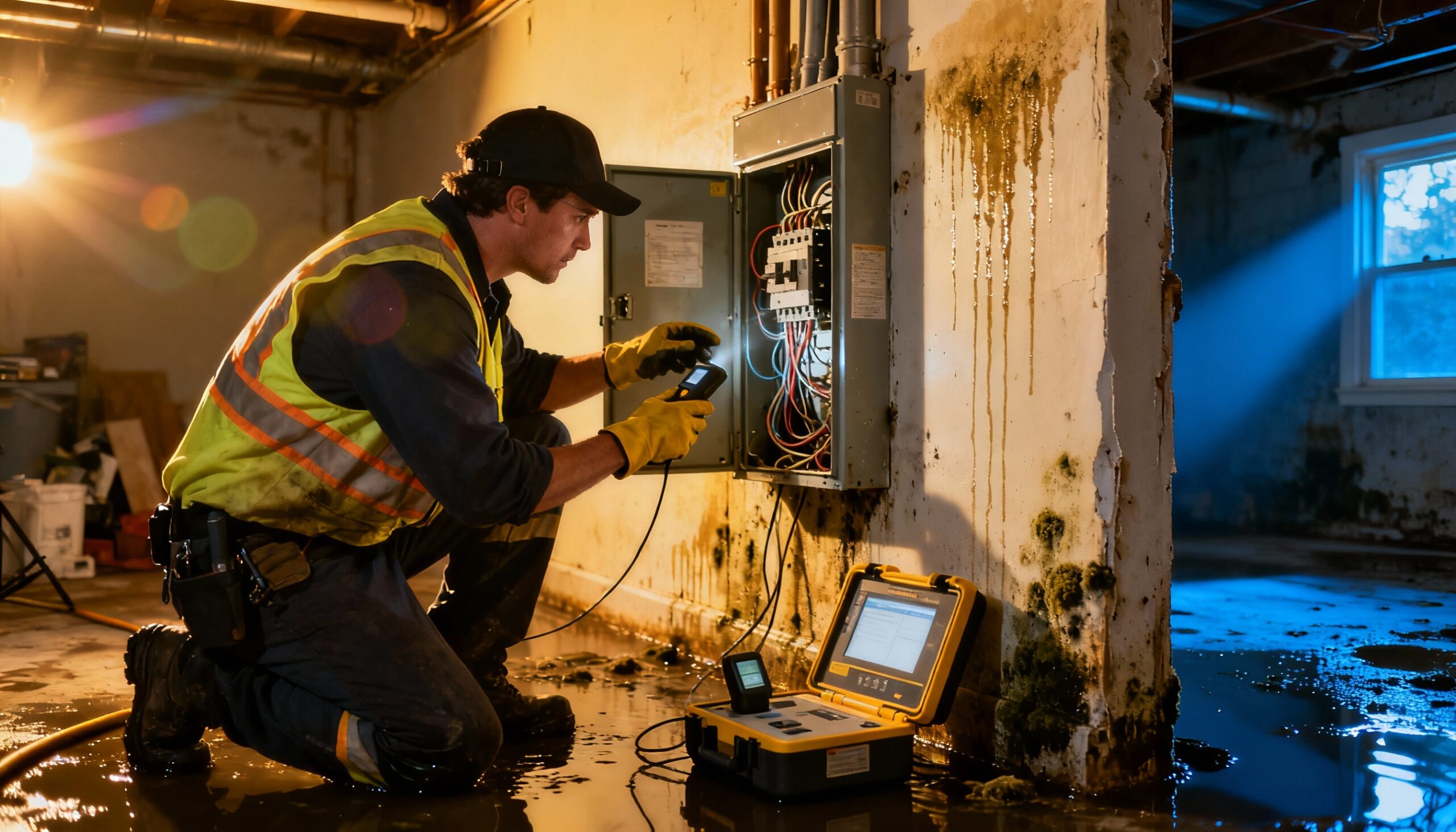What is Electrical System Water Damage?
Electrical system water damage refers to any compromise of electrical components, wiring, outlets, panels, or connected systems caused by water intrusion. This damage occurs when moisture contacts conductive materials, insulation, or the protective housings that shield electrical infrastructure from environmental hazards.
Unlike visible structural damage, electrical system water damage often remains hidden within walls, conduits, and enclosed panels. Water can travel along wiring for considerable distances, affecting components far from the original intrusion point. This migration pattern means that even minor leaks can create widespread electrical system water damage throughout a building.
The severity of electrical system water damage depends on several factors: the type of water involved, duration of exposure, and the specific components affected. Clean water from supply line breaks causes different damage patterns than contaminated floodwater, which introduces minerals, sediments, and corrosive substances that accelerate deterioration.
How Water Damages Electrical Components
Understanding the mechanisms of electrical flood damage helps property owners recognize why professional assessment is non-negotiable. Water attacks electrical systems through multiple simultaneous processes, each creating distinct safety concerns.
Corrosion and Oxidation
When water contacts copper wiring, terminals, and connection points, it initiates oxidation reactions that cause electrical system water damage. This corrosion creates resistance at connection points, generating heat during electrical flow. Over time, these hot spots can ignite surrounding materials, causing electrical fires that often start within walls where they’re difficult to detect.
The corrosion process accelerates dramatically when water contains dissolved minerals, salts, or contaminants. Floodwater is particularly damaging because it typically carries sediments and chemicals that create conductive pathways and accelerate metal deterioration.

Insulation Degradation
Electrical wiring relies on insulation to prevent current from flowing where it shouldn’t. Electrical system water damage causes this insulation to swell, crack, and lose its protective properties. Even after drying, compromised insulation may never regain its original effectiveness, leaving wires vulnerable to short circuits and arcing.
Modern wiring uses various insulation materials including PVC, rubber compounds, and thermoplastic coatings. Each responds differently to wiring water exposure, but all suffer permanent damage when submerged or exposed to prolonged moisture.
Short Circuits and Ground Faults
Water’s conductivity creates pathways for electricity to flow in unintended directions. These short circuits can trip breakers, damage connected equipment, and create shock hazards. Ground faults—where current escapes to grounded surfaces—pose particular dangers in wet environments where people may contact affected surfaces.
| Damage Mechanism | Primary Risk | Time to Manifest | Detection Difficulty |
|---|---|---|---|
| Corrosion | Fire hazard from overheating | Weeks to months | High – hidden within connections |
| Insulation breakdown | Short circuits and arcing | Days to weeks | Moderate – requires inspection |
| Ground faults | Electrocution risk | Immediate to days | Low – often trips protection |
| Contact contamination | Intermittent failures | Weeks to months | High – sporadic symptoms |
Types of Electrical System Water Damage
Different water intrusion scenarios create varying electrical system water damage patterns. Recognizing these categories helps prioritize response efforts and anticipate restoration requirements.
Flooding and Storm Damage
Electrical flood damage from natural disasters or plumbing catastrophes typically affects systems from the ground up. Outlets, switches, and wiring near floor level sustain direct immersion, while rising water can reach electrical panels, HVAC systems, and major appliances. Properties may also need emergency board-up services to prevent further damage while restoration proceeds. This comprehensive exposure often requires extensive component replacement rather than simple remediation.
Floodwater contamination compounds the damage significantly. Sewage, chemicals, and organic materials create corrosive environments that attack metal components aggressively. Properties affected by sewage contamination require specialized cleanup protocols before electrical restoration can begin. Even brief exposure to contaminated water can necessitate complete replacement of affected systems.
Roof and Ceiling Leaks
Water intrusion from above follows gravity, traveling through ceiling cavities and wall spaces, causing electrical system water damage along the way. This migration pattern means ceiling fixtures, junction boxes, and upper-floor outlets face primary exposure. However, water can travel along wiring runs, affecting components considerable distances from visible leak points.
Ceiling-origin leaks often contact light fixtures, ceiling fans, and smoke detectors—all containing electrical components sensitive to moisture. These fixtures may continue operating while electrical system water damage develops internally, creating delayed fire hazards from hidden corrosion.
Plumbing Failures and Appliance Leaks
Slow leaks from pipes, water heaters, washing machines, and dishwashers create chronic moisture exposure rather than acute flooding. This prolonged dampness can cause more severe electrical system water damage than brief immersion because components remain wet long enough for corrosion and biological growth to establish. These conditions often require mold removal and remediation alongside electrical restoration.
Appliance-related leaks frequently affect nearby outlets and the appliance’s own electrical connections. Water heater failures are particularly concerning because these units often share spaces with electrical panels and HVAC equipment.
Humidity and Condensation Damage
Not all electrical system water damage involves visible water. High humidity and condensation can deposit moisture on electrical components, particularly in unconditioned spaces like attics, crawlspaces, and garages. This gradual accumulation causes slow-developing corrosion that may go unnoticed until component failure occurs.
Warning Signs of Electrical System Water Damage
Recognizing the indicators of electrical system water damage and electrical safety water issues enables faster response and prevents dangerous situations from escalating. Some signs of electrical system water damage appear immediately, while others develop as damage progresses.
Immediate Warning Signs
Certain symptoms of electrical system water damage demand instant action and should never be ignored:
- Burning odors near outlets, switches, or electrical panels without visible cause
- Sparking or arcing when operating switches or plugging in devices
- Tripped breakers that won’t reset or trip repeatedly after resetting
- Buzzing or humming sounds from outlets, switches, or fixture boxes
- Visible water in or around electrical panels, outlets, or junction boxes
- Discoloration or staining around electrical fixtures suggesting water contact
Delayed Indicators
These symptoms of electrical system water damage may appear days, weeks, or months after water exposure:
- Intermittent power fluctuations affecting lights or equipment
- Outlets or switches that feel warm without heavy load
- Corrosion or rust visible on outlet covers or panel doors
- GFCI outlets that trip frequently without apparent cause
- Appliance malfunctions or premature equipment failures
- Increased electrical bills suggesting system inefficiency
Hidden Damage Indicators
Some electrical system water damage only reveals itself through professional inspection. Thermal imaging can detect hot spots from corroded connections. Insulation resistance testing identifies degraded wire insulation. Circuit analysis reveals intermittent faults that don’t trigger protection devices. These diagnostic methods are essential for comprehensive damage assessment.
| Warning Sign | Possible Cause | Risk Level | Recommended Action |
|---|---|---|---|
| Burning smell near outlets | Overheating from corroded connections | Critical | Shut off power, call professionals |
| Frequent breaker trips | Short circuits from damaged insulation | High | Professional inspection required |
| Warm outlets without load | Resistance from corrosion | High | Discontinue use, schedule assessment |
| Flickering lights | Loose or corroded connections | Moderate | Professional evaluation recommended |
| Rust on panel door | Moisture intrusion into panel | Moderate to High | Internal panel inspection needed |
The Professional Electrical System Water Damage Restoration Process
Restoring electrical system water damage requires systematic assessment, specialized equipment, and expertise that goes far beyond standard electrical work. The electrical system water damage restoration process follows established protocols designed to ensure safety while maximizing salvageable components.
Emergency Response and Safety Protocols
Professional restoration begins with immediate safety measures. Technicians assess whether power should remain disconnected and establish safe access to affected areas. In many cases, emergency power services may be necessary to maintain critical systems while damaged circuits remain offline. They implement lockout/tagout procedures preventing accidental energization during assessment and repair work.
Initial documentation captures the extent of electrical system water damage and visible deterioration. This documentation supports insurance claims and guides restoration planning. Moisture mapping identifies all areas affected by electrical system water damage, including those where water has traveled through concealed spaces.
Comprehensive Damage Assessment
Thorough inspection of electrical flood damage involves both visual examination and diagnostic testing. Professionals inspect:
- Main electrical panels for moisture intrusion, corrosion, and component damage
- Sub-panels and distribution equipment throughout the affected area
- Outlets, switches, and junction boxes in water-contact zones
- Wiring runs accessible through panels and visible areas
- Major appliances and HVAC equipment with electrical connections—these often require contents cleaning and restoration services
- Low-voltage systems including data, security, and communication wiring
Diagnostic testing includes insulation resistance measurements, continuity testing, and thermal imaging to identify damage invisible to visual inspection. These tests reveal compromised components that might otherwise be overlooked.

Remediation and Component Replacement
Based on assessment findings, restoration professionals develop remediation plans specifying which components require cleaning, which need replacement, and what sequence of work ensures safe restoration. Components with severe electrical system water damage that cannot be effectively cleaned are replaced entirely.
Salvageable components undergo specialized cleaning using appropriate solvents and techniques that remove contaminants without causing additional damage. Drying protocols ensure complete moisture removal before re-energization. Corrosion inhibitors may be applied to protect cleaned components from future deterioration.
Testing and Verification
Before restoring power, comprehensive testing verifies system safety and functionality. This includes insulation testing on all affected circuits, load testing to confirm proper operation, and verification that all protection devices function correctly. Documentation of these tests provides evidence that systems meet safety standards.
Preventing Electrical System Water Damage
While not all water intrusion events are preventable, strategic measures significantly reduce electrical system water damage risks and minimize damage when incidents occur. Protecting against wiring water exposure requires attention to both water management and electrical installation practices.
Water Intrusion Prevention
Effective water management forms the first line of defense against electrical system water damage:
- Regular roof inspections identifying potential leak points before problems develop
- Proper grading and drainage directing water away from building foundations
- Sump pump installation with battery backup for basement and crawlspace protection
- Water detection sensors near water heaters, washing machines, and other risk points
- Plumbing maintenance addressing minor leaks before they cause major damage
- HVAC maintenance ensuring proper condensate drainage
Electrical System Water Damage Protection
Strategic electrical installation and upgrades provide additional protection against electrical system water damage:
- Elevated electrical panels in flood-prone areas positioned above potential water levels
- GFCI protection on all circuits near water sources or in damp locations
- Weatherproof outlets and covers for exterior and garage installations
- Proper conduit and enclosures protecting wiring in vulnerable areas
- Surge protection preventing damage from electrical anomalies after flooding
Emergency Preparedness
Preparation enables faster, safer response when water events occur:
- Know your main disconnect location and how to safely shut off power
- Keep emergency contacts readily available including restoration professionals for both commercial and residential properties
- Document your electrical system with photos and panel schedules
- Maintain adequate insurance coverage including flood insurance where appropriate
- Create an emergency response plan addressing water intrusion scenarios
Regular Inspection and Maintenance
Ongoing attention to electrical safety water protection includes periodic professional inspections of electrical systems, particularly in older buildings or after severe weather events. Annual inspection of panels, GFCI function testing, and attention to any warning signs keeps systems safe and identifies problems before they escalate.
Frequently Asked Questions
How long does it take for water damage to affect electrical wiring?
Electrical system water damage begins immediately upon water contact, but visible effects develop over varying timeframes. Corrosion can start within hours, while insulation degradation may take days to weeks. Some damage only becomes apparent months later when corroded connections begin overheating. This delayed manifestation makes professional assessment essential even when systems appear functional.
Can I dry out electrical components myself after water exposure?
DIY drying of electrical components is dangerous and ineffective. Water within panels, outlets, and junction boxes requires professional extraction and assessment. Simply allowing components to air dry doesn’t address contaminants or hidden moisture that continues causing corrosion. Professional restoration includes proper cleaning, testing, and verification that ensures safety.
What are the signs that water has damaged my electrical panel?
Warning signs of electrical system water damage include rust or corrosion on the panel door or surrounding area, water stains on walls near the panel, buzzing sounds from within the enclosure, breakers that trip unexpectedly, burning odors, and visible moisture inside the panel. Any of these symptoms warrants immediate professional inspection.
Will my homeowner’s insurance cover electrical water damage restoration?
Coverage depends on your policy and the water source. Most policies cover sudden, accidental electrical system water damage from sources like burst pipes. Flooding typically requires separate flood insurance. Gradual damage from long-term leaks may not be covered. Document all damage thoroughly and contact your insurance provider promptly.
How soon should I call professionals after discovering water near electrical systems?
Contact restoration professionals immediately upon discovering water near electrical components. Every hour of delay allows corrosion to progress and electrical system water damage to compound. Quick response often means the difference between component cleaning and complete replacement. Don’t attempt to restore power or dry systems yourself before professional assessment.
Do electrical components need replacement after any water exposure?
Not necessarily, but assessment determines salvageability. Clean water exposure of short duration may allow component cleaning and restoration. Contaminated water, prolonged exposure, or significant corrosion typically requires replacement. Professional testing reveals hidden electrical system water damage that affects these decisions. Never assume components are safe without proper evaluation.

